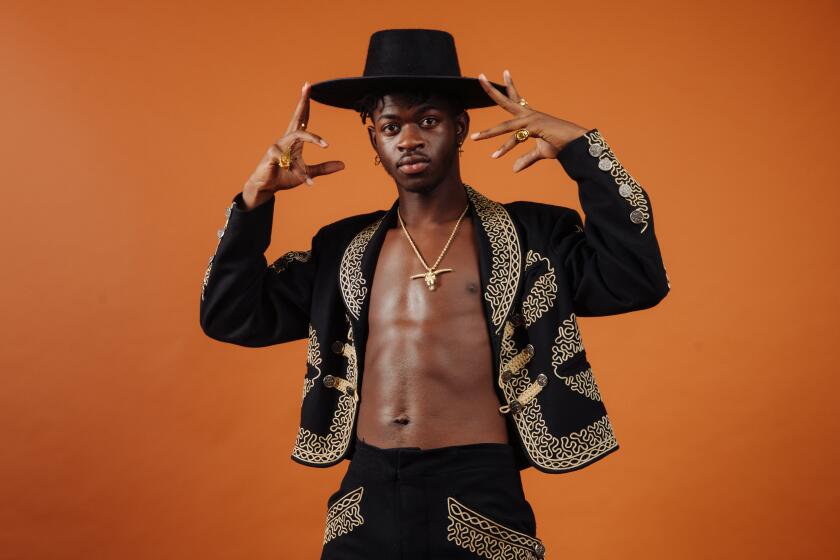Building a mystery: L.A. electronic band Lo Moon seemingly came out of nowhere

- Share via
As first impressions go, Lo Moon took its time to make an entrance.
In the fall, the Los Angeles trio had one finished song under its belt — “Loveless,” a seven-minute single of pleading falsetto scored with bedroom-eyes electronic ambiance.
A good start, for sure. But instead of finishing a few more tunes, slapping them on Soundcloud and hitting the road like most rising acts, the band put out “Loveless” with a barely there music video in September, then promptly disappeared. The local buzz Lo Moon earned seemed suspended in thin air.
It turns out the three members of the act did in fact have much more music in the tank — along with a major-label deal and an A-list producer at the helm. Lo Moon wasn’t Weeknd-style anonymous, or hiding in the shadows. Its members were just very, very patient to get it right the first time.
It was “music first. If people cared early on, they would just care about the song,” singer Matt Lowell explained, while cracking open a pamplemousse La Croix on the couch of the group’s back-house Atwater Village recording studio. “That’s all we cared about.”
When the band’s Columbia Records debut hits later this year (and when Lo Moon opens for Muna at the Teragram Ballroom on Feb. 1), fans of mascara-smeared synth-rock and hyper-modern R&B might come to care pretty quickly too.
Lo Moon is one of those young bands that seemed to come out of nowhere, fully formed. Its members knocked around the scene in other projects — Lowell had a solo outing, multi-instrumentalists Samuel Stewart and Crisanta Baker played in rowdy local staples Nightmare & the Cat and Surf Riot, respectively (Stewart is also the son of the Eurythmics’ Dave Stewart).
Lowell has a bit of Bruce Springsteen in him — preternaturally confident in his writing and singing, but also quick to defer to his bandmates on the things that make a song move. Most bands feel something like a gang, but chemistry is hard to find, and Lo Moon seem to respect the heck out of each other. When recording, Baker said, “sometimes we’d all play the same part just to see who could do it best and keep that take.”
Having done this all before, they took much more care rolling out this new band. “We had a pretty clear vision and identity from the start, so the question we’d keep asking is, ‘Does this feel like us?,’” Lowell said. “Us” meant Peter Gabriel-inspired electronic production, Fleetwood Mac-tight hooks and a bit of Cocteau Twins and the xx-style guitars to make it sadder and more lively onstage.
In its hibernation period, someone passed a demo along to Chris Walla, the former Death Cab for Cutie guitarist who is now a go-to producer for indie-leaning bands who want to go deeper and more refined in their sound.
“I get a lot of things sent to me that are good but not my thing, or are my thing but are not ready yet, and Lo Moon had a vision that was eerily clear from the start,” Walla said.
He also liked the reserved-brashness of their one-song roll-out: “It was so interesting. It never feels like the right time to do something scary and unconventional, but big, long tone poems are having a moment now. I mean, ‘Twin Peaks’ is coming back.”
The “Loveless” demo had been making rounds, and Columbia Records took the bait. A huge major is perhaps an odd fit for a band much more withholding than, say, Twenty One Pilots, but one that’s also rock enough to keep a distance from R&B and electronic music circles.
Contrary to its members’ music-biz pedigree, that success wasn’t a given: “‘Loveless’ was around for a long time and absolutely no one cared, until it ended it up with one person who did care,” Lowell said.
Major-label backing afforded Lo Moon the time to get weird — and pore over every detail for months. “It’s an incredibly rare process today. We’re so lucky,” Lowell continued. “I wonder how many great records could have been made if every band had this experience.”
Walla let the band indulge its flights of gear fancy (Baker in particular became the synth and sampler autodidact). Sometimes they wondered if their cabin-fevered ambition would send them spiraling: “There was definitely a three week period where we kind of had no idea what was going on,” Stewart said.
“It was intense,” Baker added. “There was a lot of alone time where I’d go into corner with [an old synth] and the only manual would be on some ‘90s homemade website.” But she’d force herself to figure it out, and in the end, new songs like “Real Love” and “This Is It” found a sweet spot between the forthright, romantic allure of Sade with the analog-synth clatter and sheen of Massive Attack.
Now the only question is to figure out what to do with it.
“Loveless” has earned spins on KROQ-FM and KCRW-FM, and has 2 million streams across various platforms (quite a feat for a seven-minute, whisper-soft makeout jam).
Does Lo Moon try to hit M83 heights with a festival-sized single? Slow-burn with a live show built on mystery? Stay the course with keeping fans on edge, or finally give them what they want?
“It’s always about how to create the best experience. We want to hold our own in stadiums one day,” Lowell said. With a wink of irony about his band’s long absence between its debut and LP, he added: “That’s one thing I don’t hold back from at all.”
For breaking music news, follow @augustbrown on Twitter.
ALSO
‘No, take me seriously’: Meet the Regrettes and Cherry Glazerr, L.A.’s new faces of rock
With ‘Bad and Boujee,’ Migos is finally having its moment
Muna, which doesn’t shy away from big topics, is a local band on a mission
More to Read
The biggest entertainment stories
Get our big stories about Hollywood, film, television, music, arts, culture and more right in your inbox as soon as they publish.
You may occasionally receive promotional content from the Los Angeles Times.











